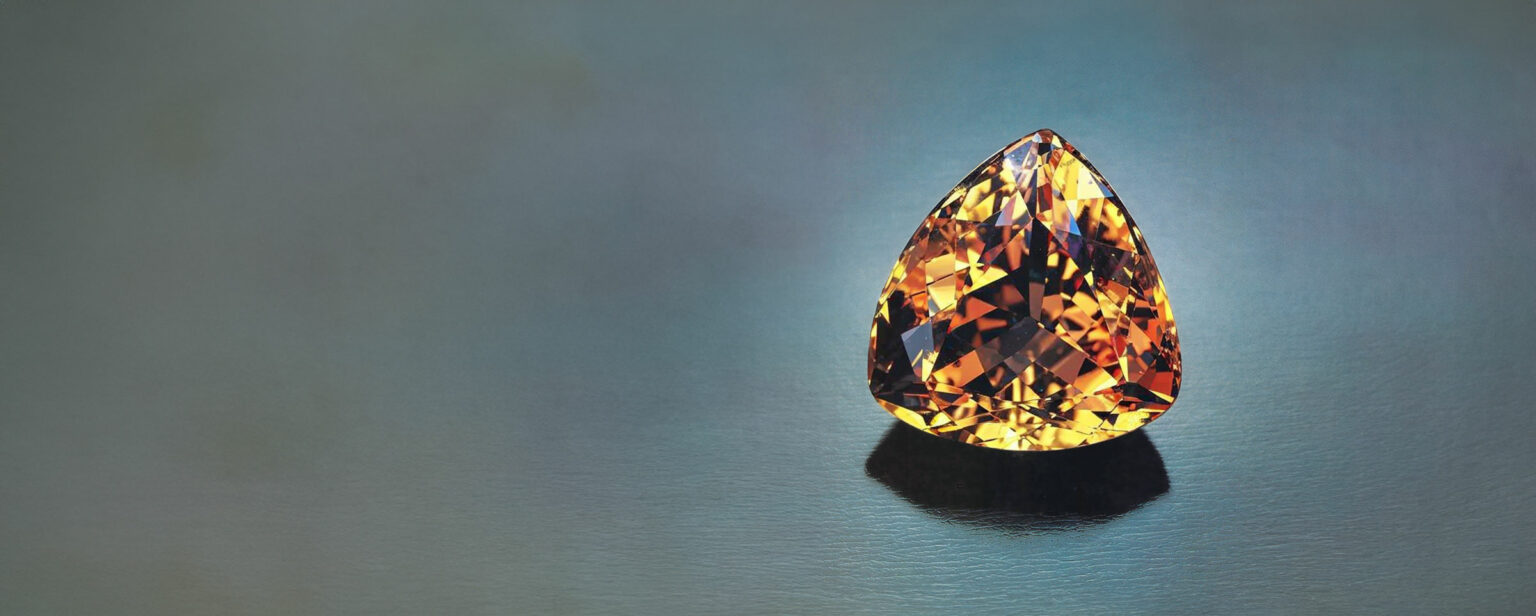The subject is citrine, or, at least, it’s supposed to be. But there’s something about this super-abundant, almost laughably affordable gem that fails to excite most dealers—or maybe just the ones we talked to. Normally voluble, they either clammed up or waited patiently to change the topic to some other gem not yet covered in these profiles.
Oh sure, they all agreed, citrine is beautiful. No one disputed that. In fact, the 240.1-carat stone on the facing page resembles the finest golden sapphires we have ever seen.
But that citrine is evidently handicapped by the fact that it costs a puny $7 per carat, $168 total! In fact, prices for comparable stunners of this Brazilian quartz were rarely quoted to us at more than $12 a carat. This indicates that citrine, no matter how lovely, is the victim of its own commonness.
In short, dealers can’t take citrine seriously for the same reasons they can’t take irradiated blue topaz seriously. It’s too cheap. You want an earth-color gem, try an expensive precious topaz or golden sapphire, even more exotic golden beryl.
For as long as this reporter can remember, citrine has been a couple-of-bucks-per-carat stone. Years ago, only dark wine-red, so-called “madeira” colors could hope to command more than $10 per carat. But with fashion colors tilted away from the hot and heavy to the light and lively, beautiful madeira stones seem hopelessly overvalued.
The action in citrine, and there is starting to be real action, is in the vivid yellows and oranges that combine so nicely with the aqua blue of topaz, the Life Saver greens and pinks of tourmaline and the happy-go-lucky violet of amethyst. “Citrine is now the biggest seller for us after blue topaz, amethyst and garnet,” says Don Golden, Samuel Goldowski Inc., New York. It’s about time.
Less is Best
The very thing about citrine that throws off dealers—namely, its very low price—is what should now endear it to jewelers. For nearly five years, ever since the market was flooded with heated yellow sapphire in early 1981, the jewelry world has seemingly thirsted for a jazzy earth-color gem. But it always overlooked the most obvious candidate: citrine. Dealers didn’t realize that the very newness of the jeweler’s appetite for a non-traditional colored stone would force him to gravitate to the affordable. Why pay $100 per carat (it was $200 per carat a while back) for yellow sapphire, when one could do just as well with a $5-per-carat yellow citrine?
Dealers will answer, there is no comparison between yellow sapphire and yellow citrine. Sapphire not only has richer color but it has greater brilliance. But here, poor cutting is partly to blame.
“At $4-5 per carat, who’s going to go to the expense to cut a citrine with the same tender loving care they do a sapphire?” asks dealer Simon Watt, Mayer & Watt, Beverly Hills, Calif. “Unfortunately, good cutting is essential for a stone like citrine.”
Brazilian gem expert Paul Heubert, Inter-Ocean Trade Co., New York, says citrine definitely gets second-class treatment from cutters. “Even the Germans, who are known for fine cutting, cut citrine with abbreviated faceting using sandstone instead of the customary wheel,” he explains. “It’s far cheaper.”
Yet despite cursory cutting, a lot of shapely citrines manage to find their way into the marketplace. And many of the best of them can still bring a hapless guess from jewelers that they are topaz, the other, far more coveted earth-color gem with which they have long been confused. Indeed, during the 1940s and 1950s, citrine was routinely sold as “topaz.” Heubert says the Gemological Institute of America has taught many jewelers to tell the difference—a difference that sometimes can only be told via testing.
Made in Brazil
Citrine is the product of Brazil—both its mines and ovens. Essentially, explains Heubert, citrines start life as either slightly smoky quartz or amethyst geodes. After heating, the smoky quartz turns clear and possesses anywhere from a light-yellow to a medium-golden color. Pop an amethyst geode in the same oven and the end result will be a brighter stone ranging in color from deep yellow to brownish red. Alas, these more prized amethyst citrines rarely come in sizes above 3 carats. “If you see an 8-carat citrine,” Heubert remarks, “it’s invariably heated smoky quartz.”
In the past, amethyst-derived citrine has been more favored. But with light-yellow and golden colors more in fashion, smoky quartz citrine is easier to sell than formerly (as long as it isn’t anemic and washed out).
Presently, according to Golden, citrine is most active in calibrated sizes from 18x13mm down to 8x6mm (3-15 carats) in both emerald and oval shapes, priced between $5 and $12 per carat. “Jewelry manufacturers want the golden colors, not the pale yellows,” Golden continues. “They’re matching them with stones like amethyst and pink tourmaline.”
In any case, the once-prized madeira color is “out,” so much so that citrine connoisseurs like Watt wonder why it was ever “in.” “The madeira is over-burned and, as a result, too dull, too brown, too over-priced,” he complains. “The orange-yellow stones have a lot more vitality.” Will golden citrine find a permanent place for itself in jewelry stores? Or will it suffer the same fate as the madeira citrine?
Dealers still feel golden quartz, too, will be subject to fashion cycles. And it certainly doesn’t help that relatively little is written about the gem—whether golden or wine colored. For instance, Robert Webster’s Gems, pays token attention to citrine —two short paragraphs in a 1,006-page book that is considered the bible of gemology.
“Citrine remains one of the best values in the gem world,” Heubert says a little wearily. “It amazes me that this gem is not more appreciated.”
Esteem for citrine may improve if the current popularity of fantasy-cut or sculptured, gems continues. Labor-intensive forms, free form cutting, first introduced by Idar-Oberstein’s Bernd Munsteiner, forces reliance on abundant and affordable stones such as irradiated blue topaz and amethyst. To bring fantasy cuts into the jewelry mainstream, firms like Overland Gems Inc., Los Angeles, and Innovative Design Corp, Abington, Pa., have introduced lines of standard sizes that generally cost jewelers no more than $10 per carat. As firms search for low-cost alternatives to topaz and amethyst, citrine, one of the most inexpensive gems around, will surely find itself paid more attention.
Please note: this profile was originally published in 1988 in Modern Jeweler’s ‘Gem Profiles: The First 60’, written by David Federman with photographs by Tino Hammid.
The 24.01-carat citrine shown in the header image is courtesy of Mayer & Watt, Beverly Hills, Calif.




